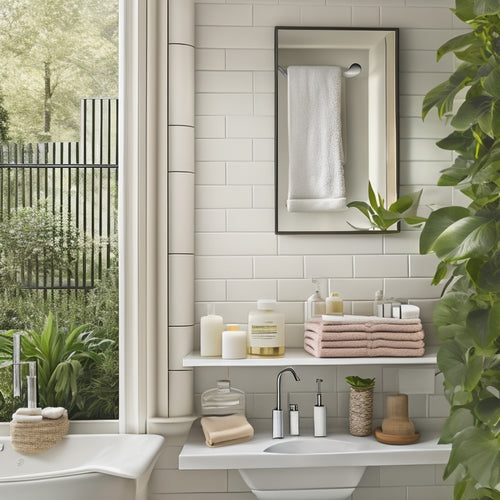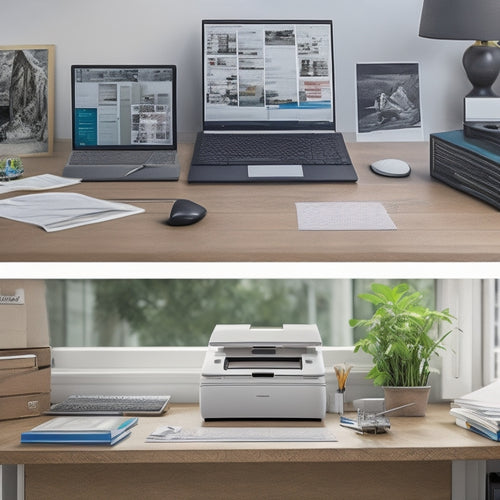
Labeling Bathroom Medicine for Emergencies
Share
You can quickly identify and access medications during emergencies by labeling them clearly with crucial information like dosage and purpose. Clear labels prevent mix-ups and guarantee medication safety. Start by labeling essential medications like pain relief options, critical medications, and natural remedies. Choose waterproof and tear-resistant labels with easy-to-read fonts and color code them for quick identification. Consider personalized icons for each family member and highlight allergies and medication interactions. Proper labeling and organization enable you to respond effectively in emergency situations, and understanding the importance of labeling is just the first step in creating a thorough emergency preparedness plan.
Key Takeaways
- Clearly labeling bathroom medicine ensures quick identification and reduces confusion during emergencies, promoting medication safety and preparedness.
- Labels should include dosage information, purpose, and expiration dates to facilitate access for caregivers or first responders in critical situations.
- Choosing the right label type, such as waterproof and tear-resistant, is crucial for bathroom conditions, and color coding aids quick identification of medication categories.
- Labeling medications by family member, including age-specific labels and personalized icons, helps distinguish between medications and addresses unique needs.
- Regularly checking expiration dates, disposing of expired medicines safely, and maintaining organization in the medicine cabinet are essential for emergency preparedness.
Importance of Labeling Medication
You likely have a collection of medications in your bathroom, each with its own set of instructions and expiration dates.
But have you ever stopped to think about what would happen in an emergency if someone, like a babysitter or a first responder, needed to access these medications? Without clear labels, it's chaos.
That's why labeling your medications is vital for medication safety and emergency preparedness.
When you're in a pinch, you don't want to be scrambling to figure out what's what. Labels guarantee that anyone can quickly identify the medication, its dosage, and its purpose.
This is especially important if you have multiple medications that look similar or have similar names. Labels also help prevent mix-ups, which can be deadly.
Common Bathroom Medicine to Label
You likely have a stash of medications in your bathroom cabinet to address common ailments.
When labeling your bathroom medicine for emergencies, it's crucial to prioritize pain relief options like acetaminophen or ibuprofen, as well as vital medications like blood pressure or asthma controllers.
Pain Relief Options
Pain relief options are an important component of any well-stocked bathroom medicine cabinet, as they provide crucial relief from headaches, fever, and body aches. You never know when you'll need to reach for something to alleviate that throbbing headache or soothe a feverish forehead.
When it comes to pain relief, you have two main options: natural remedies and over-the-counter (OTC) medications. Natural remedies like arnica gel, peppermint oil, or willow bark can provide gentle, chemical-free relief for minor aches and pains.
On the other hand, OTC medications like acetaminophen (Tylenol) or ibuprofen (Advil, Motrin) are effective for more severe pain and inflammation. You may also consider labeling a combination of both natural and OTC options, like a topical cream with arnica and ibuprofen.
Whatever your preference, make sure to label and date each item clearly, so you can easily identify what you need in an emergency.
Essential Medications
When stocking your bathroom medicine cabinet, it's crucial to include a range of medications that can help treat common ailments.
These over-the-counter essentials can be a lifesaver during emergency situations. You never know when you'll need them, and having them on hand can make all the difference.
Some must-haves in your medicine cabinet include:
- Antihistamines for allergic reactions
- Antibiotic ointments for wound care
- Anti-diarrheal medication for, well, you know
- Hydrocortisone cream for skin irritations
- EpiPens or other epinephrine injectors for severe allergic reactions
Choosing the Right Label Type
Several factors come into play when selecting the right label type for your bathroom medicine, making certain that vital information is quickly accessible during emergencies.
You'll want to take into account label durability, as bathroom conditions can be harsh, with moisture and humidity taking a toll on your labels. Look for labels that are waterproof, tear-resistant, and can withstand the humid environment.
Color coding is also essential for quick identification. Assign different colors to different categories, such as prescription medications, over-the-counter medications, and supplements. This visual system will help you and your family members quickly identify the medication they need in an emergency.
Additionally, take into account using labels with a clear, easy-to-read font and a sufficient size to guarantee that the information is easily readable, even in low-light conditions.
Labeling for Different Family Members
When labeling bathroom medicine for emergencies, you'll want to contemplate the unique needs of each family member.
You can start by including each person's name on their respective labels, and then add age-specific labels for children or elderly family members who may require different dosages or medications.
Personalized icons can also help distinguish between family members with similar names or needs.
Family Member Names
Labeling each family member's medicine with their name is essential to avoid mix-ups during emergencies. You don't want to risk giving your child's asthma medication to your spouse or vice versa. This simple step can save you from a world of trouble and potential harm.
When labeling each family member's medicine, consider the following:
-
Allergies: If a family member has a severe allergy, be certain to highlight it on the label to avoid accidental exposure.
-
Medication interactions: If a family member takes multiple medications, list them all on the label to guarantee you're aware of potential interactions.
-
Dosage instructions: Include the correct dosage and frequency to avoid overdosing or underdosing.
-
Expiration dates: Keep track of expiration dates to confirm you're not using outdated medications.
-
Special instructions: Add any special instructions, such as "take with food" or "avoid operating heavy machinery."
Age-Specific Labels
Your medicine cabinet likely contains a mix of medications for family members of different ages, from infants to seniors. When labeling these medications, it's crucial to take into account age-specific needs to guarantee safe and effective storage.
For instance, medications for infants and young children require extra precautions, such as child-resistant packaging and clear dosage instructions. On the other hand, medications for seniors may need larger print labels or simplified instructions to accommodate declining vision or cognitive abilities.
Age considerations play a critical role in medication storage. You should store medications for children and pets out of reach to prevent accidental ingestion.
For seniors, contemplate storing medications in a centralized location, like a pill box or organizer, to help them stay on track with their regimen.
Personalized Icons
As you focus on creating a safe and organized medication storage system, you'll want to guarantee each family member's medications are easily identifiable. This is especially important in emergency situations where every second counts.
One effective way to achieve this is by using personalized icons for each family member.
Assigning custom icon designs or symbols to each family member can help create strong symbol associations. This can be particularly helpful for children or individuals with visual impairments.
For instance:
- An illustration of a sun for a morning medication
- A crescent moon for a nighttime medication
- A specific animal or color for each family member
- A unique shape or logo for each person
- A simple icon indicating the medication type (e.g., a heart for blood pressure medication)
Expiration Dates and Disposal
In accordance with FDA guidelines, you're responsible for ensuring the medicines in your bathroom cabinet are up-to-date and safe for use.
It's essential to keep track of expiration dates to avoid using ineffective or even harmful medications. Implement an expiration tracking system by labeling each medicine with the expiration date or the date you should replace it. This way, you'll know exactly when to toss that expired antibiotic or pain reliever.
When it's time to dispose of expired or unused medicines, make sure to do it safely.
Don't flush them down the toilet or throw them in the trash, as this can harm the environment and contaminate waterways. Instead, take advantage of community drug take-back programs or drop-off locations. You can also check with your local pharmacy or law enforcement agency to see if they've a medicine disposal program.
Tips for Maintaining Organization
Several strategies can help you maintain organization in your bathroom medicine cabinet.
You've labeled and purged your medicine cabinet, but now it's time to keep it that way. Implementing a few simple storage solutions and organizational systems will guarantee your cabinet remains tidy and functional.
To maintain organization, consider the following:
- Assign a "home" for each item, making it easy to find what you need in an emergency
- Store items by category, such as pain relievers, antihistamines, and ointments
- Use baskets or bins to corral small items, keeping them from getting lost or scattered
- Keep frequently used items in easy-to-reach locations, reserving higher or lower shelves for less-used items
- Schedule regular clean-outs to remove expired or unused medications and replenish supplies as needed
Frequently Asked Questions
Can I Use Stickers to Label Medicine Bottles for Easier Removal?
You can use stickers to label medicine bottles, but choose removable vinyl or paper stickers, and apply gentle removal methods like peeling or warm water to avoid residue, ensuring easy reuse.
How Do I Label Medicine for Guests or Temporary Visitors?
When hosting guests, you'll want to prioritize guest safety and emergency preparedness by clearly labeling medicines with their names, dosages, and expiration dates, ensuring your visitors can easily identify and access essential medications in case of an emergency.
Can I Label Medicine With a Permanent Marker Instead of Labels?
A million things can go wrong, but labeling medicine with a permanent marker won't be one of them! You'll be safe with a durable marker that won't fade, and ink safety won't be a concern - just make sure to choose a reputable brand.
Are There Any Specific Label Sizes Recommended for Medicine Bottles?
When choosing labels, you'll want to follow label size guidelines to guarantee readability; standard label dimensions range from 1x2 to 4x6 inches, so pick the one that fits your bottle and style, and don't let your labels get lost in the mix!
Can I Reuse Labels if I Switch to a Different Medicine?
Imagine swapping out your favorite coffee creamer, only to find the label stuck to the new one - a sticky situation! You shouldn't reuse labels when switching medicines, as label durability suffers, compromising medicine identification and potentially leading to mix-ups.
Conclusion
As you gaze into your newly organized bathroom cabinet, imagine a haven of clarity and calm. Labels on medication bottles shine like lighthouses, guiding you through life's unexpected twists and turns. With expiration dates and contents at a glance, you're enabled to respond to emergencies with confidence. Your labeling system is the unsung hero, quietly keeping your family safe and healthy.
Related Posts
-

Creative Open Shelving for Bathroom Displays
You're looking to change your bathroom into a serene oasis, and creative open shelving is the perfect way to showcase...
-

Drawer Inserts for Modern Bathroom Aesthetics
You invest in a modern bathroom aesthetic, but cluttered drawers and disorganized storage can quickly undermine the s...
-

Easy Tips to Resize Printables for Any Paper Size
To resize printables for any paper size, it's crucial to understand the importance of maintaining aspect ratio and pr...


